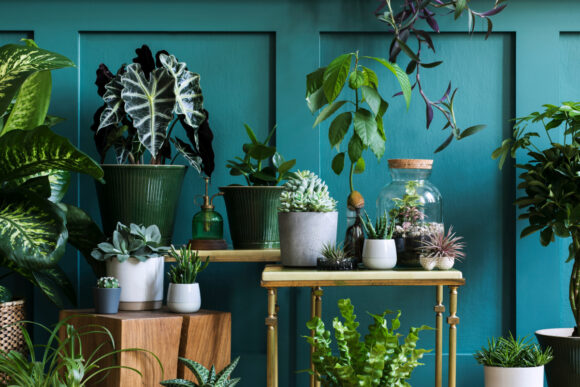 Celebrating National Indoor Plant Week – By Joel Flagler
Celebrating National Indoor Plant Week – By Joel Flagler
The relationship between people and plants has been many thousands of years in the making. We have been interacting with plants long before the term “horticulture” was conceived.
Our earliest ancestors relied on plants to survive. They learned to recognize which vegetation offered the likelihood of finding water, provided a good escape from danger and strategic views of game animals and gave them food, fiber, fuel, medicine and more.
Today we rely on plants for all the same survival needs. The difference is that we are so removed from the source that we don’t realize the relationship is as true today as it was for our earliest ancestors. Indeed, we need plants a whole lot more than they need us.
Plants are still at the beginning of every food chain. They give us all material needs and something we do not see—oxygen. And compelling data from NASA shows certain plants are very effective at reducing indoor air pollution.
It is widely accepted that what we have learned about the roles of plants in medicine and nutrition has significantly contributed to our improved physical health. We are now learning to recognize and utilize plants for improved mental health, healthier communities and social development. There are more reasons than ever to have live plants around: They make us feel better, reduce stress and much more.
Plants are nonthreatening (for the most part), nonjudgmental, nondiscriminating and respond to any caregiver. In a world of constant judgment, this is quite special. Anyone can be successful with plants on some level; there are no prerequisites. You can start tomorrow or this afternoon. Moreover, research shows that plant successes can lead to other life successes, especially for individuals with disabilities and special needs.
With summer waning, it is time to turn our attention to indoor gardens. Our need to be around plants doesn’t end with the first frost. The human need to be close to nature is acute during wintertime’s long nights and darkness. Research shows we are at our best around plants and they help us recover from mental and emotional fatigue.
At the same time, they improve indoor air quality and thus a healthier environment in places where we live and work. Thanks to their unique ability to manufacture their own food through photosynthesis, live green plants don’t need to be fed. More importantly, they take in carbon dioxide – the poisonous gas we exhale – while giving us fresh oxygen. Oxygen has its own direct human benefits, including increased productivity and fewer sicknesses. In corporate settings, indoor plants, which are often large and impressive tropical trees, are credited with contributing to decreased sick time, less turnover and more employee pride and satisfaction.
Those same benefits are there for us in our homes. The NASA research, led by Bruce Wolverton, indicates certain plants are more effective at removing indoor contaminants than others. The good news is these plants are widely available and won’t break the bank. Further, many are tolerant of lower light.
“How to Grow Fresh Air” by Wolverton includes these plants and their relative ability to remove key toxins from our indoor air. These toxins are released from commonly used materials in dry cleaning, paint, rubber, pressed wood products, cleaning solutions and adhesives. They are the sources for trichloroethylene (TCE), considered a potent carcinogen by the American Cancer Society; formaldehyde, which leeches from all white paper products; and benzene, which is common in plastic, inks and detergents and linked to kidney and liver disease as well as irregular heartbeat and respiratory problems.
We must recognize the dangers of indoor contaminants, especially in the cold months when tight-fitting energy-efficient windows and doors keep all air fresh air out. The build-up of toxins is greater when there are many pressed wood products – sometimes used as subflooring and shelving and in cabinetry and furniture – and other items named above.
The best plants to use indoors – and improve indoor air pollution – includes Dracena marginata; Spathiphyllum (Peace Lily); Dracena Janet Craig, Dracena massangiana; Chamadorea (Bamboo Palm); Chlorophytum (spider plant); Gerbera daisy; Dieffenbachia (dumb cane) and English ivy.
The third week of September is National Indoor Plant Week. It’s time to start an indoor garden or add to an existing one. We also can bring in geraniums before the frost hits and enjoy them as indoor plants along with some of the superstars named above.
_______________________________________________________________________________
Joel Flagler is a Rutgers alum (CC ‘74) and has been on the faculty since 1988. He is a professor of Horticultural Therapy at the Rutgers School of Environmental and Biological Sciences and the Rutgers Agricultural Extension Agent for Bergen County.

